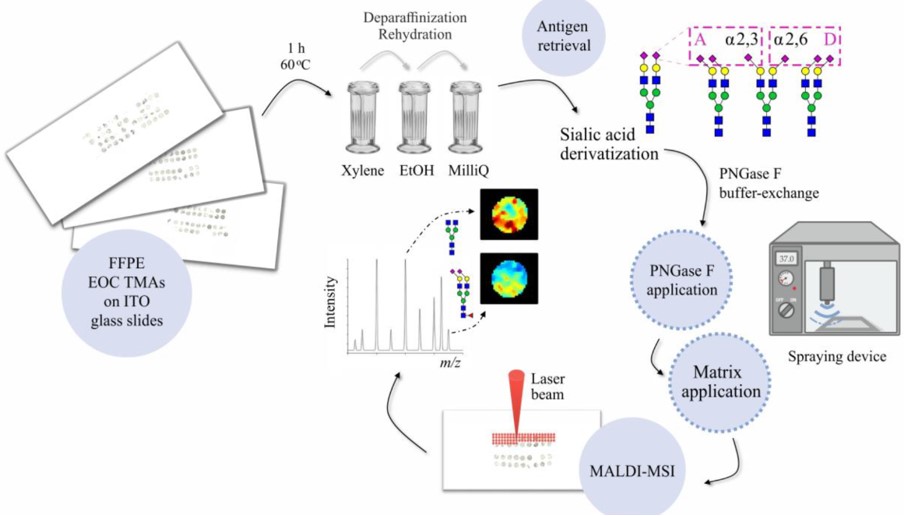Tumor Tissue Glycoprofiling Service
Professional Glycoprofiling Analysis of Tumor Tissues at Creative Biolabs
Glycosyl modifications play a key role in many important biological processes. Glycoprofiling analysis of tumor tissues can provide key information for an in-depth understanding of tumor biology, discovery of biomarkers, exploration of new therapeutic targets, and understanding of tumor heterogeneity, which is of great significance for tumor research and clinical applications. Creative Biolabs has established a first-class glycoprofile analysis platform, and we are committed to providing professional tumor tissue glycoprofiling services to global clients.
Glycoprofiling of tumor tissue is a complex and precise process, which generally involves the following steps:
Tissue lysis and protein removal
We put tumor tissue samples into a lysis solution (such as a mixture containing phosphate buffer saline) and use mechanical or chemical methods (such as enzymatic hydrolysis) to completely lyse the tissue to release internal biomolecules, including proteins and sugars.
Next, we use protein precipitants or organic solvents (such as chloroform, and methanol) to precipitate the proteins and remove the proteins by centrifugation.
Then, we wash the extracted supernatant to remove residual proteins, salts, and other interfering substances.
Enrichment and purification of sugars
We use column chromatography, solid phase extraction, or other purification methods to concentrate and purify sugars for subsequent analytical steps.
Derivatization of sugar
We chemically derivatize the extracted sugar samples to enhance their detection sensitivity and stability in the mass spectrometer.
Chromatographic separation
We use techniques such as high-performance liquid chromatography (HPLC) or capillary electrophoresis (CE) to separate and quantify derivatized sugars. Thereby determining the presence and concentration of different sugars and preparing for subsequent mass spectrometry analysis.
Mass spectrometry analysis
We use a variety of high-resolution mass spectrometry techniques to perform comprehensive glycoprofiling on the derivatized samples to determine the presence of different sugars and how they are connected. Moreover, we use bioinformatics tools to conduct a professional analysis of the mass spectrometry data obtained and generate a complete sugar spectrum analysis report, including the detected sugar components, relative content, structural characteristics, and other information.
Through the above steps, we conduct a comprehensive and in-depth analysis of the sugar profile in tumor tissues, providing important information for understanding tumor biological processes and formulating personalized treatment plans.

Publication
Technology: Matrix-assisted laser desorption/ionization mass spectrometry imaging (MALDI-MSI)
Journal: Cancers
IF: 6.886
Published: 2022
Results: The authors used MALDI-MSI combined with detection technology of specific sialic acid derivatization to study N-glycan distribution in epithelial ovarian cancer (EOC) tissue. The results showed that different amounts of N-glycans could be detected in tissue samples, and due to the application of the sialic acid derivatization method, α2,3- and α2,6-sialylated N-glycan species were distinguished. This detection method can be used as an effective strategy to discover biomarkers of glycosylation.
 Fig.1 Analysis workflow of MALDI-MSI.1, 2
Fig.1 Analysis workflow of MALDI-MSI.1, 2
Advantages
-
We have extensive experience in analyzing tumor tissue glycoprofiling and can handle complex samples and interpret analysis results.
-
We use the latest technologies and methods to continuously improve the level and efficiency of tumor tissue glycoprofiling service.
-
We provide accurate and reliable tumor tissue glycoprofiling analysis data to provide important support for clients' decision-making and research.
Application
-
Glycoprofiling of tumor tissue guides the selection of personalized treatment options and helps develop more precise treatment plans and monitoring strategies.
-
Analyzing the sugar profile in tumor tissue provides clues for the design and development of new drugs and helps discover potential therapeutic targets.
-
Glycoprofiling analysis of tumor tissue helps find and verify specific markers in tumor tissue, which are used as indicators for early diagnosis, prognosis assessment, and treatment monitoring.
Creative Biolabs has a specialized Glycoprotein Analysis platform, and we have established scientific and standardized quality control standards and processes to ensure the accuracy and reliability of tumor tissue glycoprofiling analysis results. Please feel free to contact us if you would like to inquire about specific analysis services.
References
-
Grzeski, Marta, et al. "In situ N-glycosylation signatures of epithelial ovarian cancer tissue as defined by MALDI mass spectrometry imaging." Cancers 14.4 (2022): 1021.
-
Under Open Access license CC BY 4.0, without modification.
For Research Use Only.
Related Services


 Fig.1 Analysis workflow of MALDI-MSI.1, 2
Fig.1 Analysis workflow of MALDI-MSI.1, 2



